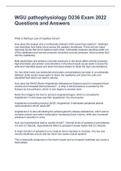Starling forces - Study guides, Class notes & Summaries
Looking for the best study guides, study notes and summaries about Starling forces? On this page you'll find 237 study documents about Starling forces.
Page 2 out of 237 results
Sort by
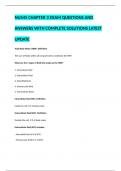
-
NU545 CHAPTER 3 EXAM QUESTIONS AND ANSWERS WITH COMPLETE SOLUTIONS LATEST UPDATE
- Exam (elaborations) • 24 pages • 2024
- Available in package deal
-
- $9.99
- + learn more
NU545 CHAPTER 3 EXAM QUESTIONS AND ANSWERS WITH COMPLETE SOLUTIONS LATEST UPDATE Total Body Water (TBW): Definition The sum of fluids within all compartments constitutes the TBW What are the 5 types of fluid that make up the TBW? 1. Intracellular fluid 2. Extracellular fluid 3. Interstitial fluid 4. Intravascular fluid 5. Transcellular fluids Intracellular fluid (ICF): Definition Inside the cell, 2/3 of body water Extracellular fluid (ECF): Definition Outside the cell, 1/3 of body wa...
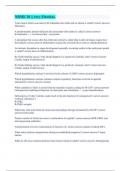
-
NBME 30 || very Flawless.
- Exam (elaborations) • 7 pages • 2024
- Available in package deal
-
- $10.66
- + learn more
Total calorie deficit associated with redundant skin folds and no edema is called? correct answers Marasmus A predominantly protein-deficient diet associated with edema is called? correct answers Kwashiorkor —> no Korean bbq = no protein A disruption that occurs after the embryonic period is called (that is after all major organs have developed)? correct answers Deformation (caused by external forces such as oligohydramnios) An intrinsic disruption in organ development generally oc...
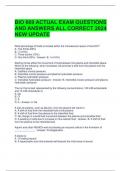
-
BIO 669 ACTUAL EXAM QUESTIONS AND ANSWERS ALL CORRECT 2024 NEW UPDATE
- Exam (elaborations) • 13 pages • 2024
-
- $13.99
- + learn more
BIO 669 ACTUAL EXAM QUESTIONS AND ANSWERS ALL CORRECT 2024 NEW UPDATE What percentage of fluids is located within the intravascular space of the ECF? A. Two thirds (66%) B. ¼ (4-5%) C. Three fourths (75%) D. One third (33%) - Answer- B. ¼ (4-5%) Starling forces affect the movement of fluid between the plasma and interstitial space. Which of the following, when increased, will promote a shift from the plasma into the interstitial space A. Capillary oncotic pressure B. Interstitial ...
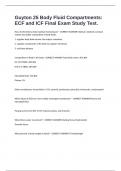
-
Guyton 25 Body Fluid Compartments: ECF and ICF Final Exam Study Test.
- Exam (elaborations) • 8 pages • 2024
- Available in package deal
-
- $13.99
- + learn more
Guyton 25 Body Fluid Compartments: ECF and ICF Final Exam Study Test. How do the kidneys help maintain homeostasis? - CORRECT ANSWER Maintain relatively constant volume and stable composition of body fluids: 1. regulate body fluid volume (via output/ retention) 2. regulate constituents of EC fluid (via output/ retention) 3. acid-base balance Composition of fluid in the body - CORRECT ANSWER Total body water: 60% BW ICF (2/3 TBW): 40% BW ECF (1/3 TBW): 20% BW Interstitial fluid: 15%...
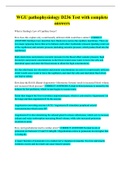
-
WGU pathophysiology D236 Test with complete answers
- Exam (elaborations) • 35 pages • 2023
- Available in package deal
-
- $12.99
- 1x sold
- + learn more
WGU pathophysiology D236 Test with complete answers What is Starling's Law of Capillary forces? How does this explain why a nutritionally deficient child would have edema? How does the RAAS (Renin-Angiotensin-Aldosterone System) result in increased blood volume and increased blood pressure? How can hyperkalemia lead to cardiac arrest? The body uses the Protein Buffering System, Phosphate Buffering System, and Carbonic Acid-Bicarbonate System to regulate and maintain homeostat...

-
NU545 CHAPTER 3 EXAM QUESTIONS AND ANSWERS WITH COMPLETE SOLUTIONS GRADED A++ LATEST UPDATE
- Exam (elaborations) • 10 pages • 2024
- Available in package deal
-
- $10.49
- + learn more
NU545 CHAPTER 3 EXAM QUESTIONS AND ANSWERS WITH COMPLETE SOLUTIONS GRADED A++ LATEST UPDATE extracellular fluid interstitial fluid, plasma, intravascular fluid, CSF, sweat, urine, etc. store less fat, higher metabolic rates, and greater evaporative loss why are infants more susceptible to significant total body water loss renal what mechanisms are not mature enough that regulate fluid and electrolyte conservation; leads to dehydration adipose cells individuals with more body fat have pro...
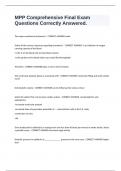
-
MPP Comprehensive Final Exam Questions Correctly Answered.
- Exam (elaborations) • 17 pages • 2024
- Available in package deal
-
- $11.49
- + learn more
MPP Comprehensive Final Exam Questions Correctly Answered. The major constituent of plasma is - CORRECT ANSWER water Select all the correct responses regarding hematocrit: - CORRECT ANSWER -Is an indicator of oxygen carrying capacity of the blood -is the % of red blood cells to total blood volume -Is the portion of the blood where you would find hemoglobin Thrombin - CORRECT ANSWER plays a role in clot formation The ventricular diastolic phase is associated with - CORRECT ANSWER ...
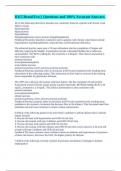
-
D115 Renal/Uro || Questions and 100% Accurate Answers.
- Exam (elaborations) • 11 pages • 2024
- Available in package deal
-
- $11.49
- + learn more
All of the following electrolyte disorders are commonly found in a patient with chronic renal failure, except: Hypernatremia Hypocalcemia Hyperkalemia Hypophosphatemia correct answers Hypophosphatemia Feedback:Electrolyte disorders commonly seen in patients with chronic renal failure include hyperkalemia, hyperphosphatemia, hypocalcemia, and bicarbonate deficiency. The advanced practice nurse sees a 78-year-old patient who has complaints of fatigue and difficulty emptying his bladder. Ex...
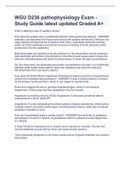
-
WGU D236 pathophysiology Exam -Study Guide latest updated Graded A+
- Exam (elaborations) • 32 pages • 2022
-
- $12.99
- 2x sold
- + learn more
What is Starling's Law of Capillary forces? How does this explain why a nutritionally deficient child would have edema? - ANSWER Starling's Law describes how fluids move across the capillary membrane. There are two major opposing forces that act to balance each other, hydrostatic pressure (pushing water out of the capillaries) and osmotic pressure (including oncontic pressure, which pushes fluid into the capillaries). Both electrolytes and proteins (oncontic pressure) in the blood affe...
WGU pathophysiology D236 Exam 2022 Questions and Answers

Study stress? For sellers on Stuvia, these are actually golden times. KA-CHING! Earn from your study resources too and start uploading now. Discover all about earning on Stuvia



